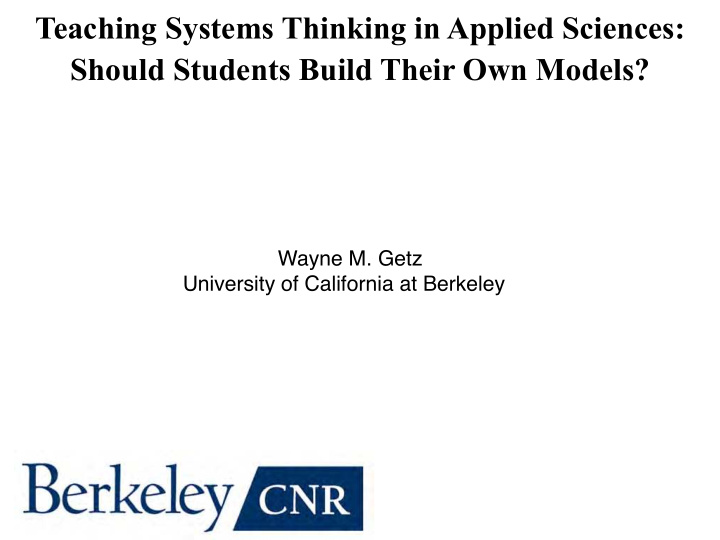



Teaching Systems Thinking in Applied Sciences: Should Students Build Their Own Models? Wayne M. Getz University of California at Berkeley
A current challenge
Why build models of systems 12 points from NRC text: 1. Provide coherent framework 2. Highlight basic concepts 3. Exploration uncovers new phenomena 4. Identify key factors/components 5. Link across scales (e.g. individual & populations) 6. Formalize intuitive understanding 7. Screen hypothesis 8. Inform experimental design 9. Predict values that cannot be easily measured 10. Link what is known to what is yet unknown 11. Generate accurate predictions 12. Expand range of questions that can be meaningfully asked
The conundrum The utility of software applied to big data problems, such as identifying patterns, classifying or a categorizing objects tagged by data, is self-evident through the results produced: either something useful emerges or the software fails to produce good results (weak vs strong methods) The validity of software used to evaluate the impacts of management actions on complex ecosystems is very hard to verify prior to such actions being implemented: once implement actual outcomes can be compared to predicted outcomes, but this is often a one-point comparison with experiments hard to repeat and time horizons are generally large (some times multigenerational) (good vs bad models)
Example of a platform that could work very well without the user knowing “the physics”
Example of a platform that provides a knowledgeable user with a very useful tool
Example of a platform that may be very useful but could be dangerous in the hands of an unqualified user
Preparing applied scientists to use models as an aid to managing complex environmental and ecological systems Two examples: • California Department of Fisheries and Wildlife (CDFW) are charged with recommending dam release schedules to protect fall run Chinook salmon in the San Joaquin River system • WHO/CDC/US Military healthcare professionals charged with assisting in-country management of the outbreak of Ebola Viral Disease in West Africa
Playing back the simulation results
The Ebola Crisis
EVD outbreak in West Africa still ongoing but, thankfully, numbers are much, much lower than predicted one year ago
Simulation Data (cases per week) The data do not show a homogeneous outbreak pattern, but suggest the existence of considerable spatial inhomogeneity
Ebola: transmission chain model Basic chain latent Treatment chain infectious period period recovery isolated (Exp state ) (Inf state ) V i if T i or death U 1 s =0 s 2 Healthcare vaccinate s 2 s 1 worker detected transmission U i transmission s 1 s * 0 U 2 0 Global isolated s 1 s 2 H j time line Local time lines s * = s 1 s 2 0 t =0 U: infected in community (Exp or Inf states ); V: vaccinated ; T: infected and isolated H: infected healthcare worker (Exp or Inf states, immediately isolated ) λ ( t ) max force of infection Poisson force of infection education reduces contact rates over min force of infection global time Probability of isolation
Nova implementation: population of “victims” creation of offspring distribution is critical 18
Nova online app 19
More and more, complex systems models implemented as “web apps” are becoming available for general use Are we thereby enabling Hawking’s aphorism? “the greatest enemy of knowledge is not igorance, it is the illusion of knowledge” If so, can we mitigate this through education? Do we need to insist that anyone using some elses model should, at least, have some experience in building their own models of similar, albeit simpler, systems? My feeling is that model building experience is critical when it comes to using the “canned” models of others! Maybe we should even require individuals to have “model user licenses” equivalent to Masters level degrees in the health sciences
Thanks
Recommend
More recommend